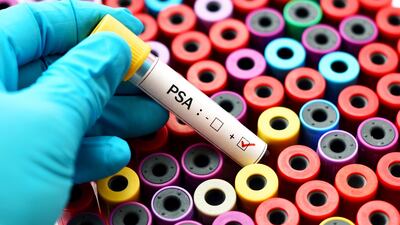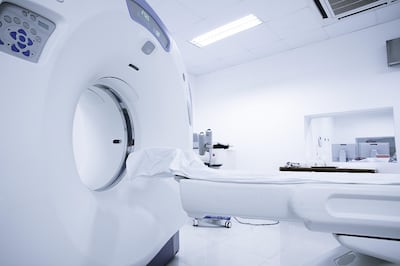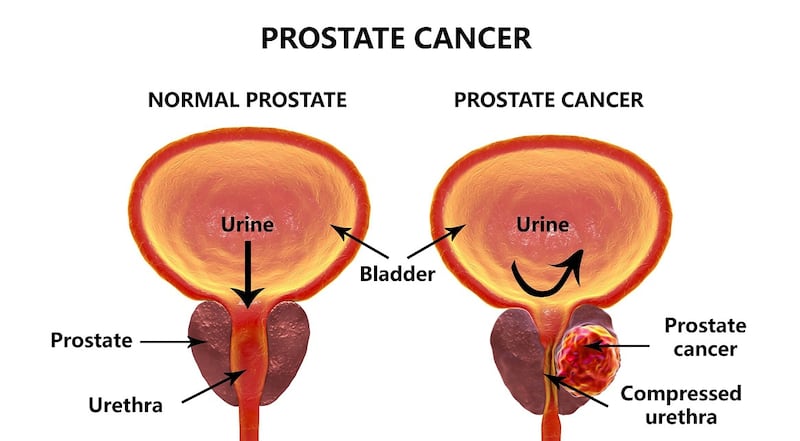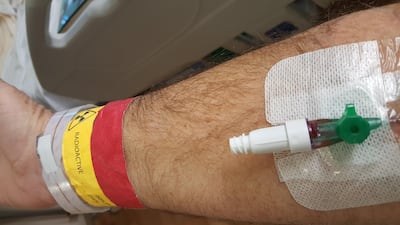I made it to my 66th birthday without having been a hospital patient since the week of my birth.
I know how lucky that is.
I have had the same GP for 30 years, and he has often said to me that he believes in the science of blood. Every six months or so, he would test my blood and I would email him for the results. Until January 2017, the response would merely be a cholesterol reading. However, for the first time, he said my PSA (prostate specific antigen) level was elevated and another test was needed.

The second blood test in March confirmed the higher reading (it was 10). I needed to see a consultant urologist and my doctor asked if I wanted to proceed in the public or private system. For the first time in 40 years, I chose to use my health insurance.
My GP gave me a letter for a consultant in Clane Hospital in Co Kildare. My medical history comprised three lines – one line about blood pressure, one about cholesterol and one about gastroenteritis, which was so long ago I don't remember it. While waiting for the appointment in Clane, I searched the internet for references to the PSA test and took comfort from the fact there were question marks around its predictive value for prostate cancer.
The diagnosis
After a prostate biopsy in March, the consultant said he saw nothing unusual in the gland and that he would forward the biopsy to Tallaght Hospital. He said I could expect to receive the results in about three weeks.
Four weeks later, I had heard nothing, but felt Easter may have caused delays in the laboratory.
A few weeks later, I got a letter for a follow-up with the urologist in May.
At the meeting, I told the consultant I didn’t have any results to discuss with him, and I hoped I wasn’t wasting his time.
He said he had the results and proceeded to guide me through a diagnosis of early prostate cancer. In short, I had clinical stage T1 prostate cancer, which was concentrated mostly in the right lobe (25 per cent in four of six cores). The left lobe had just a trace of cancer (5 per cent) in one of six cores.
I recall vividly my response was: “Wow – I wasn’t expecting that.”
The next stage of the process was to have an MRI and bone scan. These were needed to see if the cancer was contained within the prostate gland, or whether it had spread. Until this question was answered, there could be no treatment plan. Before finishing with the consultant, he expressed a view that the MRI and bone scan would be clear. He also gave me his last copy of an excellent Irish Cancer Society booklet entitled, Understanding Early Prostate Cancer.

When I arrived home on May 9th, I broke the news to my wife. We discussed informing our two children, who were now adults and living away from home. At the time, our daughter was having medical tests to discover the cause of a weakened immune system so I suggested we avoid adding to her concerns and hold off on telling either of them for the time being. Until the MRI and bone scan, we would not have enough information on treatment options anyway. The bone scan was done on May 15th at the Hermitage Clinic in Dublin and the MRI in Clane Hospital on May 18th. I returned to Clane Hospital on May 30th to meet the consultant and get the results of these scans. Both scans were clear so it was then a question of where to from here.
Treatment options
I had read the Irish Cancer Society booklet given to me in Clane and it appeared I had a number of treatment options, two of which amounted to surveillance rather than action. The consultant mentioned that if I did nothing, I would be unlikely to encounter medical difficulties for 10-15 years, but that taking the right course of action now would be likely to cure the cancer.
Based on the advice, I really had three options:
– Brachytherapy;
– External beam radiotherapy;
– Surgery.
The consultant said selecting a treatment would be my call and that the clinicians would intervene only if they thought I was favouring a wrong option. He did mention that brachytherapy was unlikely to be a suitable option for me as my prostate gland was too large. He said he would now be handing my case to a consultant in the Hermitage Clinic and was doing so in the belief that my cancer would be cured.
Treatment process
My first conversation with the Hermitage consultant was on June 19th. Having reviewed my case, he also said my cancer would be cured. He re-iterated that my prostate was too large for brachytherapy, but introduced another treatment option – CyberKnife. I quickly agreed to that option. However, patients are only accepted into the CyberKnife programme after their cases have been reviewed by a team of clinicians, which meets monthly.
Following consideration of my case by the team, I was informed in early July that my prostate was too large for CyberKnife and they would begin planning for the external beam radiotherapy.

For the first time since my diagnosis, I felt a real sense of disappointment.
A few days later, I received a call from a radio therapy specialist at the Hermitage, who asked me if, in light of the early diagnosis in my case, I would give permission to seek a second opinion from a consultant radiation oncologist in Galway. I told her that day (and a few times since!) how much I appreciated the call. The radiation specialist raised the prospect of going on hormone therapy for a number of months to reduce the size of my prostate and thereby re-open the possibilities for brachytherapy and CyberKnife. In the meantime, detailed preparations would begin in August for the external beam radiotherapy.
External beam radiotherapy requires a scan to pinpoint the locations for the treatments. In my case, I received three tiny permanent marks (I call them my tattoos!) during a scan in September. However, there was to be another twist. A few days later, I received a call from a consultant in the Hermitage to say that there was concern within the clinical team that the prostate gland was of such a size that the external beam radiotherapy posed a risk of radiation damage to nearby organs. That day, I received a prescription (tablets and an injection) which started me on a three-month course of hormone therapy to reduce the size of my prostate.
Hormone therapy
As Christmas approached, I had been on the hormone treatment for almost three months and feeling hot and cold flushes during the night. On the coldest of nights, I would sleep outside the bed clothes only to wake up freezing, return to under the blanket, and repeat every few hours. In mid-December, word came through that the consultant in Galway would like to see me with the specific purpose of using ultrasound to accurately measure the size of my prostate. Before I had embarked on the hormone treatment, my prostate was estimated at close to 90 grams, which was well in excess of the maximum acceptable figure of 50 grams for brachytherapy. I attended the Galway Clinic on January 4th and had an ultrasound volume study undertaken. The consultant confirmed that the prostate gland was at 47.7 grams and was within the brachytherapy range. I was elated.
Pending examination of my file, and consultation with the clinical staff in the Hermitage, he would begin planning for brachytherapy (the insertion of radio-active seeds directly into the prostate). He asked me to meet him again at the Hermitage on January 16th and that day it was agreed by all that I would be scheduled for brachytherapy at the earliest opportunity.
Brachytherapy procedure
The date for my procedure was settled as Thursday, February 1st, 2018.
The procedure was planned for about 3pm and, all going well, I would be allowed home about 8pm. An anaesthetist asked about any previous reactions I may have had to a general anaesthetic. As this was going to be a first, I couldn’t answer the question. The surgeon came out to speak to me and told me they would take very good care of me.
I walked into the theatre at about 3.15pm, lay down on the bed, was administered the general anaesthetic and the next thing I remember is waking up and people asking if I was alright. It was all done and dusted in about an hour and, just to prove it, I had two new wristbands saying “radioactive”!
Other than a slightly fuzzy head, and a sore throat, I felt fine. My bed was wheeled back to the day ward where I was fed some tea and toast (my first food in 24 hours) and, after about an hour, I was taken by wheelchair for a CT scan to ensure the brachytherapy seeds were placed correctly in the gland. Back in the ward it was heading towards 8pm and my wife arrived. A chicken sandwich and some tea arrived too, so I was in my element. It was almost time to go home, or so I thought.

Our daughter (who still knew nothing about my predicament) was coming to stay with us for the night. She was texting and phoning both of us to know why we had not yet arrived home. Meanwhile, following post-procedure tests, the medical staff in the Hermitage were unhappy with my blood pressure, heart rate and, most importantly, oxygen level. They said there was a danger of me having developed a blood clot. The consultant said I should be given an anti-clot injection immediately, remain in the Hermitage overnight and have another CT scan in the morning.
I was very unhappy, largely because my wife (who played a blinder all along) was going home alone to explain to our daughter what had been happening over the past year, and why she had been kept in the dark. I asked about the process of discharging myself, but a doctor, and my wife, talked sense into me. My wife went home and later in the night I had a telephone conversation with my daughter, which was great.
I had a reasonably restful night and a nurse came by at 6am to repeat the tests I had had the previous evening. Everything had improved. At 9am on Friday, February 2nd, a nurse arrived to take me for a CT scan (my second in two days).
A doctor came to examine me and said he was confident the scan would confirm there was no clot. So I could leave? Afraid not.
My consultant (now in Galway) would not agree to my release until he had been informed of the scan result. I asked permission from a nurse to get dressed to make me feel like I was going home. She agreed. Three hours since the CT scan and news came through that the scan system was down. A senior staff member gave me permission to leave on the clear understanding I would return immediately if called upon by the clinic. I left the premises as though a fire alarm had gone off (strange reaction given how well I was treated), walked up to the Lucan road to cross over the footbridge into Liffey Valley Shopping Centre, where I planned to have a cream cake to celebrate my escape.
It was really noisy from all the traffic and I didn’t hear my phone ring but I did feel the vibration of a message received. The missed call was from the Hermitage. I toyed with the idea of not checking the message, heading home for a shower, and then seeing if I was required back. Anyway, I decided to return the call immediately and was told that the scan was clear.
On Saturday morning, February 3rd, I was out for a walk and my phone rang. It was the consultant from Galway. He apologised for keeping me in the Hermitage on Thursday night and explained that the medical concerns which arose appeared to be linked to my reaction to the general anaesthetic. He confirmed that everything went to plan in the theatre and the scan was clear.
The following Wednesday, our son was coming to stay with us. I collected him from his apartment and told him the story of what had happened over the past year. Thankfully, he understood the reason behind the delayed flow of information.
I was back in the Hermitage in March for a follow-up. I found out at that consultation that my journey which had started with PSA reading of 10 was concluding with a reading of 0.4. I will have further PSA tests every six months or so.
Lessons learned
I have learned a few things through this experience. The first is that the three significant health issues I have had in my life had no symptoms for me. All three were picked up during my regular visits to my doctor. The GP really is such a key link in the medical chain.
The second is that I am glad that I kept up my health insurance through all the years that I had no health scares. When I telephoned Irish Life Health, they were very helpful and confirmed that my insurance covered the various procedures.
The third is that the only definitive answer on prostate cancer diagnosis comes from a biopsy.
And finally, in this journey through prostate cancer, every person that dealt with me was extraordinarily professional, kind, and, in my opinion, quite brilliant.
A lucky man indeed.








